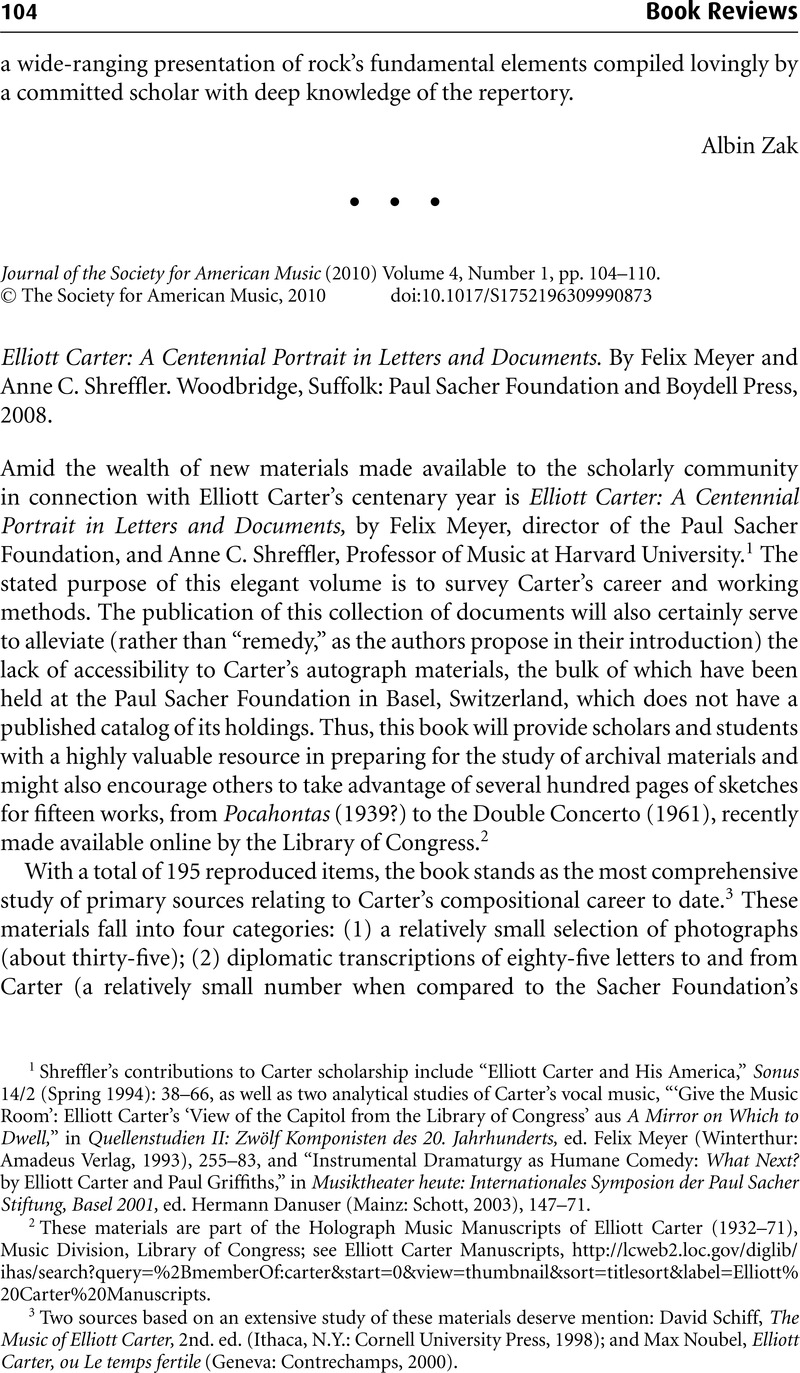No CrossRef data available.
Article contents
Elliott Carter: A Centennial Portrait in Letters and Documents. By Felix Meyer and Anne C. Shreffler. Woodbridge, Suffolk: Paul Sacher Foundation and Boydell Press, 2008.
Published online by Cambridge University Press: 14 January 2010
Abstract

- Type
- Book Review
- Information
- Copyright
- Copyright © The Society for American Music 2010
References
1 Shreffler's contributions to Carter scholarship include “Elliott Carter and His America,” Sonus 14/2 (Spring 1994): 38–66, as well as two analytical studies of Carter's vocal music, “‘Give the Music Room’: Elliott Carter's ‘View of the Capitol from the Library of Congress’ aus A Mirror on Which to Dwell,” in Quellenstudien II: Zwölf Komponisten des 20. Jahrhunderts, ed. Felix Meyer (Winterthur: Amadeus Verlag, 1993), 255–83, and “Instrumental Dramaturgy as Humane Comedy: What Next? by Elliott Carter and Paul Griffiths,” in Musiktheater heute: Internationales Symposion der Paul Sacher Stiftung, Basel 2001, ed. Hermann Danuser (Mainz: Schott, 2003), 147–71.
2 These materials are part of the Holograph Music Manuscripts of Elliott Carter (1932–71), Music Division, Library of Congress; see Elliott Carter Manuscripts, http://lcweb2.loc.gov/diglib/ihas/search?query=%2BmemberOf:carter&start=0&view=thumbnail&sort=titlesort&label=Elliott%20Carter%20Manuscripts.
3 Two sources based on an extensive study of these materials deserve mention: Schiff, David, The Music of Elliott Carter, 2nd. ed. (Ithaca, N.Y.: Cornell University Press, 1998)Google Scholar; and Noubel, Max, Elliott Carter, ou Le temps fertile (Geneva: Contrechamps, 2000)CrossRefGoogle Scholar.
4 Before the publication of the present volume, Carter's writings had been made available in two collections: Stone, Else and Stone, Kurt, eds., The Writings of Elliott Carter (Bloomington: Indiana University Press, 1977)Google Scholar; and Bernard, Jonathan W., ed., Elliott Carter: Collected Essays and Lectures, 1937–1995 (Rochester, N.Y.: University of Rochester Press, 1997)Google Scholar.
5 More avid readers will want to refer to Link, John F., Elliott Carter: A Guide to Research (New York: Garland Publishing, 2000)Google Scholar, and Carter's own Harmony Book, ed. Nicholas Hopkins and John F. Link (New York: Carl Fischer, 2002).
6 A good starting point is David Schiff, “A Paper Mountain: Elliott Carter's Sketches,” and Bernard, Jonathan W., “Elliott Carter: Concerto for Orchestra (1965–69),” in Settling New Scores: Music Manuscripts from the Paul Sacher Foundation, ed. Meyer, Felix (Mainz: Schott and Zurich: Paul Sacher Stiftung, 1998), 115–26Google Scholar. Another helpful resource is Vermaelen's more detailed discussion of Carter's precompositional methods and the various stages that may characterize the realization of a score such as that of “Anaphora” from A Mirror on Which to Dwell; see Vermaelen, Denis, “Elliott Carter's Sketches: Spiritual Exercises and Craftsmanship,” in A Handbook to 20th-Century Musical Sketches, ed. Hall, Patricia and Sallis, Friedemann (New York: Cambridge University Press, 2004), 161–75Google Scholar.


